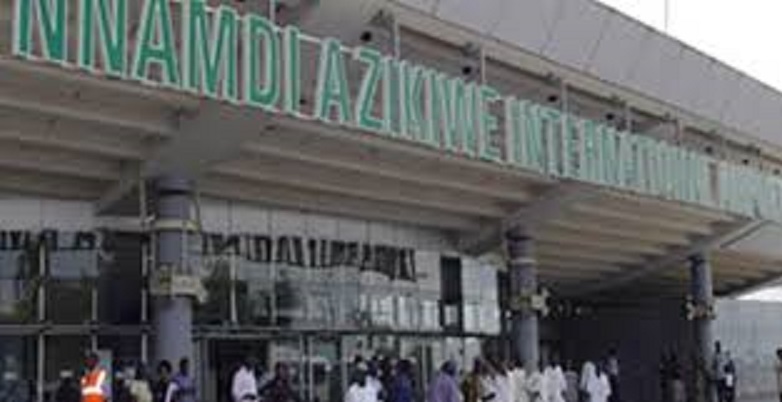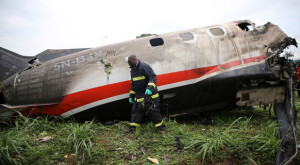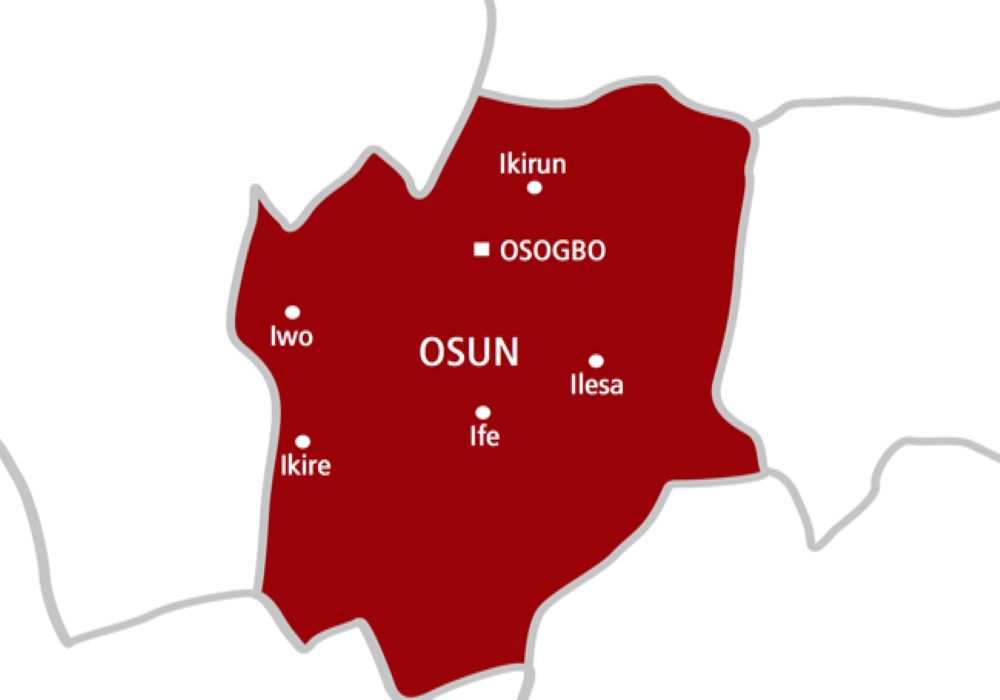Aviation
AIB blames pilots, others for four Nigerian plane crashes
LAGOS-THE Accident Investigation Bureau has indicted pilots of four crashed aircraft in the country as well as the Nigerian Airspace Management Agency and its Area Controllers in some of the locations were the accidents occurred.
The AIB stated this in the final report on the accidents that occurred within the Nigerian airspace, including that of the Beechcraft 1900D, with registration 5N-JAH belonging to Wings Aviation Services Air.
The others are the Cessna Citation 560XLS, with registration 5N-BMM, belonging to Bristow Helicopters; Boeing 737-500, with registration 5N-BLE, belonging to Aero Contractors; and AS 350 B2, with registration 5N-BHU, belonging to OAS Limited.
The AIB said the Beech 1900D aircraft was on a revenue positioning flight on March 15, 2008 and crashed at about 0920 hours in a mountainous terrain at Bushi Village, Obalinku Local Government Area of Cross River State. The bureau had on March 29, 2009 issued an interim report on the accident.
The final report stated that the aircraft deviated from the filed flight plan route and flew through the airway direct to Ikrop instead of Potgo-Enugu and Bebi direct, adding that the inputs into the Global Positioning System gave the crew different distances to Bebi. It stated, “The crew agreed on a coordinate to input, and thereafter were busy trying to locate the airstrip physically.
During this process, the Ground Proximity Warning System gave signals and sound of ‘Terrain, terrain… pull up, pull up’ several times without any of the pilots following the command. “The aircraft flew into the terrain and crashed. The flight crew and passenger were fatally injured. The airplane was destroyed and there was post-crash fire.”
The report noted that the Flight Data Recorder showed that the aircraft crashed at about 9.20am at an altitude of about 3,400ftm, while the plane flew for 103.75 minutes. It said the flight crew did not respond promptly to the GPWS warning, adding that they were not familiar with the route in a situation of low clouds, poor visibility and mountainous terrain.
The report also indicted the Area Controllers in the region of the crash, stressing that they “did not detect the estimates as passed by the pilot for position not in the filed flight plan.” Still on the contributory factors to the crash of the Beech 19000D aircraft, the AIB said “The erroneous co-location of Bebi airstrip and Obudu on the NAMA chart confused the crew.” Three persons were on the flight, the two flight crew members and one passenger, the report added.
On the Bristow Helicopters’ Cessna Citation 5N-BMM incident, the bureau said the flight departed Lagos at 1856hours for Port Harcourt on an Instrument Flight Rules and estimated Port Harcourt at 1940hours. It noted that on the final approach, the crew had visual challenge but continued the approach, crash landed and exited the runway.
The AIB stated, “The aircraft was cleared to maintain flight level 330. The aircraft made the first contact with Port Harcourt at 1914hours. The pilot reported maintaining FL330 with six souls on-board, four hours fuel endurance and estimating Port Harcourt VOR at 1940hours. “At 1921hours, the pilot reported 100 nautical miles to Port Harcourt and requested for descent. The aircraft was cleared or descent through different levels and finally cleared for the straight instrument landing system Approach Runway 21 and to report on the localizer. On final approach the crew were no longer visual but continued the approach, crashed landed and exited the runway.”
The investigation identified the causal factors of the crash to include “the decision of the pilot to continue the approach without the required visual reference.” It noted that other contributory factors were poor crew coordination, pairing two captains together and marginal weather condition. On the Aero Contractors Flight 210, a Boeing 737-500 registered as 5N-BLE, the report stated that the airplane skidded off the runway 28, while landing on approach into the Yakubu Gowon Airport, Jos, Plateau State. The aircraft departed Lagos on the fateful day with two pilots, three flight attendants and 87 passengers on board.
The AIB said, “The aircraft commenced an approach and touched down with the Right Main Wheel 135 metres from the threshold, skidded off the runway 28 to the left into the grass area, damaged three runway light assembles and uprooted the armoured cables at the airport. All 92 persons on-board sustained little or no injury, and the aircraft was substantially damaged.”
The causal factors were identified as the decision of the crew to continue the approach in an unstable condition, coupled with the captain’s inappropriate attempt to take over control of the aircraft. Other contributory factors include fatigue, which impaired the captain’s performance and reflected the effects of a long, demanding duty day associated with check airmen functions; poor crew resource management; and the prevailing weather condition.
On the OAS Limited aircraft 5N-BHU incident, the report stated that the helicopter was conveying the managing director and staff of a business firm to a meeting in Port Harcourt. After departing Lagos at about 0713hours, the aircraft could not continue the flight to Port Harcourt and was returning to the Osubi airstrip due to bad weather.
The report stated, “At 0904hours, the pilot could not give his position when requested by the Air Traffic Controller and collided with high tension cables belonging to the Power Holding Company of Nigeria located along the road to the Delta Steel Company in Delta State.” It added that three survivors were evacuated from the wreckage, while the fourth person was found fatally injured outside the aircraft. “One of the three survivors later died in the hospital,” the report stated.
The causative factor for the crash was identified as the “pilot’s decision to conduct the flight under a Special Visual Flight Rule in an Instrument Meteorological Condition as depicted by the weather forecast.” Contributory factors included “the pilot’s descent from 500ft without a clear visual reference and the pilot was not instrument rated.”
Speaking on the outcome of the report, the Commissioner/Chief Executive Officer, AIB, Dr. Felix Abali, said the bureau would ensure unbiased investigations into aircraft accidents and serious incidents. “At the AIB, we are committed to enhancing aviation safety by conducting thorough and unbiased investigations into aircraft accidents and serious incidents. We are currently working hard to release more accident reports in the shortest possible time,” Abali added.
PUNCH-
Aviation
Accra Bound Aircraft Loses Engine Mid-Air After Departing NAIA, Abuja

An Abuja-Accra flight experienced technical difficulties mid-air on Friday, forcing it to return to Abuja, shortly after departure.
The Nigerian Safety Investigation Board (NSIB) made the disclosure in a statement, adding that it has launched investigation into what it described as a serious accident.
Director, Public Affairs and Family Assistance, NSIB, Bimbo Olawumi Oladeji stated that preliminary investigations revealed the aircraft experienced an engine number two indication issue.
ALSO READ: BREAKING: Kyari Oversees NNPC Ltd’s Transparent Recruitment Aptitude Test
It was gathered that the aircraft, with registration number 5NKAL which was operating a flight from the Nnamdi Azikiwe Airport, Abuja (DNAA), to Kotoka International Airport, Accra (DGAA).
She explained that four persons were onboard when the incident occurred. The crew immediately requested for a diversion back to Abuja due to the engine indication.
Oladeji added that the crew managed to safely land the aircraft at Abuja Airport at 18:16 UTC.
There were no injuries reported, and all individuals on board are safe.
Aviation
FG Secures 12 Pre-Owned Alpha Jets to Bolster Nigeria’s Air Power
Nigeria has acquired 12 pre-owned Alpha Jets from the French Air Force as part of efforts to enhance the operational capacity of the Nigerian Air Force (NAF).
The deal, facilitated through SOFEMA, a French military and aeronautics company, was announced by Olusegun Dada, Special Assistant to President Bola Tinubu on via X on Thursday.
He said, “All the 12 aircraft are ready for shipping.”
The Alpha Jet, a product of Franco-German collaboration, is a versatile military aircraft designed for light attack and advanced training missions.
READ MORE: JUST IN: FG Battles Against Seizure Of Presidential Jets In France
Equipped to carry bombs, rockets, and missiles, the aircraft also features a gun pod for close air support.
The NAF already operates 11 Alpha Jets, but this latest procurement signals a significant boost to its fleet.
Dada also confirmed that the Air Force is expecting 24 M-346FA light attack aircraft, ordered during the administration of former President Muhammadu Buhari.
The first batch of these Italian-made aircraft is expected to arrive early next year.
Air Chief Marshal Hasan Abubakar, the Chief of Air Staff, described the acquisitions as a testament to President Tinubu’s commitment to bolstering the armed forces.
“This renewal of our aircraft fleet reflects the government’s commitment to ensuring the safety and security of Nigerians,” Abubakar said.
The announcement comes on the heels of President Tinubu’s three-day state visit to France, where he met with French President Emmanuel Macron.
The visit, which took place from November 27 to November 30, highlighted deepening ties between the two nations.
To ensure the sustainability of its expanding fleet, the Air Force has proposed establishing a local maintenance hub.
Speaking in October, Abubakar noted that six units of the M-346FA aircraft were already in production, with the initial batch of three expected to be delivered in early 2025. The full fleet is projected to arrive by 2026.
“These developments underscore the importance of creating a domestic support system for the long-term upkeep of our aircraft,” Abubakar added.
Aviation
Festive Season: Aero Contractors Slashes Ticket Prices To N80,000
As the holiday season draws near, Aero Contractors has introduced a minimum ticket price of N80,000 for all local flights.
The move, which will last until January 2024, aims to ease the financial burden on Nigerians amid the high cost of living.
Ado Sanusi, Managing Director of Aero Contractors, made the announcement on Tuesday during a press briefing, describing the fare reduction as a gesture to help Nigerians celebrate Christmas and the New Year without the stress of steep ticket prices.
READ MORE: Bobrisky Defends Egungun of Lagos Amid Viral Video Scandal
Sanusi said, “We understand the economic hardship Nigerians are facing, especially with high ticket prices, and we know the holiday season is nearby.
“In the spirit of Christmas, Aero Contractors has introduced what we call pocket-friendly Christmas prices. These fares, starting at N80,000, will apply to all our destinations, allowing Nigerians to travel without excessive costs.”
As of Tuesday afternoon, an economy class ticket from Lagos to Abuja was priced at N99,643, while business class tickets were being sold for N189,167.
Sanusi further explained that the initiative was designed to make it easier for families to reunite during the holidays.
“This is a way for us, as an organization with a long history of serving Nigerians, to give back to our loyal customers. We want to make it possible for families to meet their loved ones during this festive season without worrying about exorbitant travel costs,” he added.




















